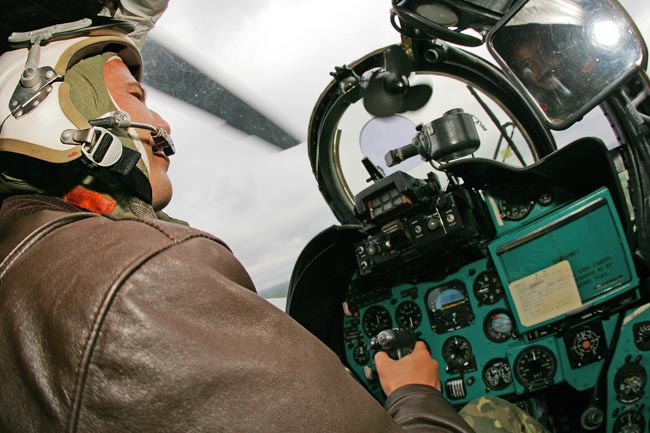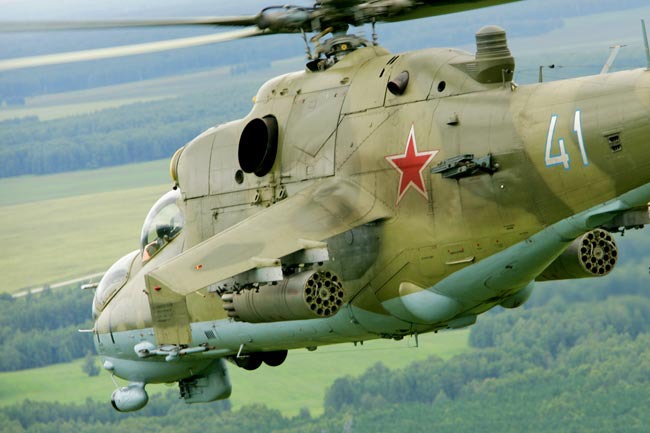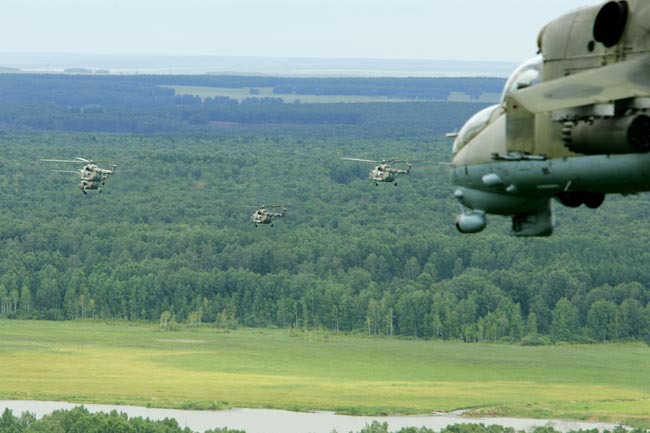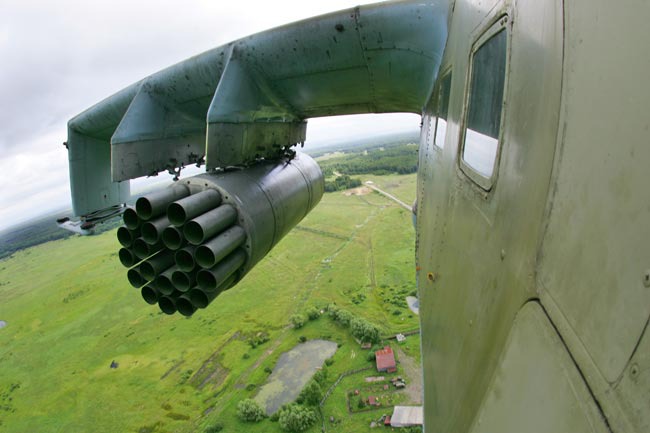Russia's Mi-24 Battle Helicopter

The Mil Mi-24 (Cyrillic Миль Ми-24, NATO reporting name 'Hind') is a large helicopter gunship and low-capacity troop transport produced by Mil Moscow Helicopter Plant and operated from 1972 by the Soviet Air Force, its successors, and over thirty other nations. In October 2007, the Russian Air Force announced it would replace its 250 Mi-24 helicopter gunships with 300 more modern Mi-28s and possibly Ka-50s by 2015
The Mil Mi-24 (Cyrillic Миль Ми-24, NATO reporting name 'Hind') is a large helicopter gunship and low-capacity troop transport produced by Mil Moscow Helicopter Plant and operated from 1972 by the Soviet Air Force, its successors, and over thirty other nations. In October 2007, the Russian Air Force announced it would replace its 250 Mi-24 helicopter gunships with 300 more modern Mi-28s and possibly Ka-50s by 2015

In NATO circles the export versions, Mi-25 and Mi-35, are simply denoted with a letter suffix as "Hind D" and "Hind E" respectively. Soviet pilots called the aircraft летающий танк (letayushchiy tank, “flying tank”). More common unofficial nicknames were Крокодил (Krokodil, “Crocodile”), due to the helicopter's new camouflage scheme and Стакан (Stakan, “Glass”), because of the flat glass plates which surrounded the three place cockpit of the Mi-24A.
In NATO circles the export versions, Mi-25 and Mi-35, are simply denoted with a letter suffix as "Hind D" and "Hind E" respectively. Soviet pilots called the aircraft летающий танк (letayushchiy tank, “flying tank”). More common unofficial nicknames were Крокодил (Krokodil, “Crocodile”), due to the helicopter's new camouflage scheme and Стакан (Stakan, “Glass”), because of the flat glass plates which surrounded the three place cockpit of the Mi-24A.

During the early 1960s, it became apparent to Soviet designer Mikhail Leont'yevich Mil that the trend towards ever-increasing battlefield mobility would result in the creation of flying infantry fighting vehicles, which could be used to perform both fire support and infantry transport missions. The first expression of this concept was a mock-up unveiled in 1966 in the experimental shop of the Ministry of Aircraft's factory number 329 where Mil was head designer. The mock-up designated V-24 was based on another project, the V-22 utility helicopter, which itself never flew. The V-24 was similar in layout and configuration to the UH-1A Huey, with a central infantry compartment that could hold eight troops sitting back to back, and a set of small wings positioned to the top rear of the passenger cabin, capable of holding up to six missiles or rockets, with a twin-barreled GSh-23L cannon fixed to the landing skid.

The aircraft was operated extensively during the Soviet invasion of Afghanistan, mainly for bombing Mujahideen fighters. The US supplied heat-seeking Stinger missiles to the Mujahideen, and the Soviet Mi-8 and Mi-24 helicopters proved to be favorite targets of the rebels
The aircraft was operated extensively during the Soviet invasion of Afghanistan, mainly for bombing Mujahideen fighters. The US supplied heat-seeking Stinger missiles to the Mujahideen, and the Soviet Mi-8 and Mi-24 helicopters proved to be favorite targets of the rebels

Mi-24s were supplied to the Afghan government in April 1979 to deal with Mujahideen guerrillas. The Afghan pilots were well-trained and made effective use of their machines, but the Mujahideen were not easy targets. The first Mi-24 to be lost in action was shot down by guerrillas on 30 May 1979. The situation in Afghanistan grew worse and on 25 December 1979, Soviet troops were committed to the war.

After a brutal learning curve in the face of Afghan rebels, Mi-24 pilots learned to be dangerous and cruel themselves, and the rebels called the Mi-24 "Shaitan-Arba" (Satan's Chariot)". In one case, a Mi-24 pilot who was out of ammunition managed to rescue a company of infantry by maneuvering aggressively towards Mujahideen guerrillas and scaring them off. The Mi-24 was popular with ground troops, since it could stay on the battlefield and provide fire as needed, while "fast mover" strike jets could only stay for a short time before heading back to base to refuel.
After a brutal learning curve in the face of Afghan rebels, Mi-24 pilots learned to be dangerous and cruel themselves, and the rebels called the Mi-24 "Shaitan-Arba" (Satan's Chariot)". In one case, a Mi-24 pilot who was out of ammunition managed to rescue a company of infantry by maneuvering aggressively towards Mujahideen guerrillas and scaring them off. The Mi-24 was popular with ground troops, since it could stay on the battlefield and provide fire as needed, while "fast mover" strike jets could only stay for a short time before heading back to base to refuel.

The Mi-24's favoured munition was the 80-millimetre (3.1 in) S-8 rocket, the 57 mm (2.2 in) S-5 having proven too light to be effective. The 23 mm (0.91 in) gun pod was also popular. Extra rounds of rocket ammunition were often carried internally so that the crew could land and self-reload in the field. The Mi-24 could carry ten 100-kilogram (220 lb) iron bombs for attacks on strongpoints, while harder targets could be dealt with a load of four 250-kilogram (550 lb) or two 500-kilogram (1,100 lb) iron bombs. Some Mi-24 crews became expert "snipers" dropping or tossing bombs precisely on targets. Fuel-air explosive bombs were also used in a few instances, though crews initially underestimated the sheer blast force of such weapons and were caught by shock waves that rattled their teeth.



